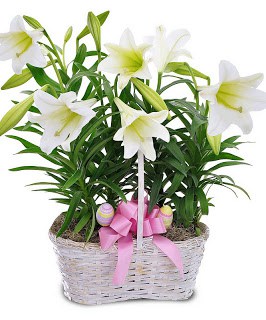Easter Lilies! They are only here for a short time and are oh so beautiful! Here is some info on how they came to be associated with the Easter season.
THE EASTER LILY HOLIDAY TRADITION
Each holiday is marked by cherished traditions that bring joy, comfort, and
warmth, and provide continuity from one generation to the next. Easter has
its share of traditions: egg decorations and hunts; gift baskets and
chocolate bunnies, sunrise church services, parades, and, of course, the
Easter Lily. For many, the beautiful trumpet-shaped white flowers
symbolize purity, virtue, innocence, hope and life – the spiritual essence of
Easter.
History, mythology, literature, poetry and the world of art are rife with
stories and images that speak of the beauty and majesty of the elegant
white flowers. Dating back to Biblical lore, the lily is mentioned numerous
times in the Bible. One of the most famous Biblical references is in the
Sermon on the Mount, when Christ told his listeners: “Consider the lilies of
the field, how they grow: they toil not, neither do they spin; and yet…..
Solomon in all his glory was not arrayed like one of these.”
Often called the “white-robed apostles of hope,” lilies were found growing
in the Garden of Gethsemane after Christ’s agony. Tradition has it that the
beautiful white lilies sprung up where drops of Christ’s sweat fell to the
ground in his final hours of sorrow and deep distress. Churches continue
this tradition at Easter time by banking their alters and surrounding their
crosses with masses of Easter Lilies, to commemorate the resurrection of
Jesus Christ and hope of life everlasting.
Since the beginning of time, lilies have played significant roles in
allegorical tales concerning the sacrament of motherhood. Ancient fables
tell us the lily sprang from the milk of Hera, the mythological Queen of
Heaven.
The pure white lily has long been closely associated with the Virgin Mary.
In early paintings, the Angel Gabriel is pictured extending to the Virgin
Mary a branch of pure white lilies, announcing that she is to be the mother
of the Christ Child. In other paintings, saints are pictured bringing vases
full of white lilies to Mary and the infant Jesus.
The legend is told that when the Virgin Mary’s tomb was visited three days
after her burial, it was found empty save for bunches of majestic white
lilies. Early writers and artists made the lily the emblem of the
Annunciation, the Resurrection of the Virgin: the pure white petals
signifying her spotless body and the golden anthers her soul glowing with
heavenly light.
It seems the thirteenth-century Barthololmeus Anglicus had this in mind
when he wrote: ‘The Lily is an herbe with a white flower; and though the
leaves of the floure be white, yet within shineth the likeness of gold.” So
goes the saying, ‘To gild a lily is to attempt, foolishly, to improve on
perfection.” To many artists and poets it seemed that, if any flower could
have one, the lily had a soul.
In yet another expression of womanhood, lilies had a significant presence
in the paradise of Adam and Eve. Tradition has it that when Eve left the
Garden of Eden she shed real tears of repentance, and from those
remorseful tears sprung up lilies. The spiritual principle held here is that
true repentance is the beginning of beauty.
A mark of purity and grace throughout the ages, the regal white lily is a
fitting symbol of the greater meaning of Easter. Gracing millions of homes
and churches, the flowers embody joy, hope and life. Whether given as a
gift or enjoyed in your own home, the Easter Lily serves as a beautiful
reminder that Easter is a time for rejoicing and celebrating.







